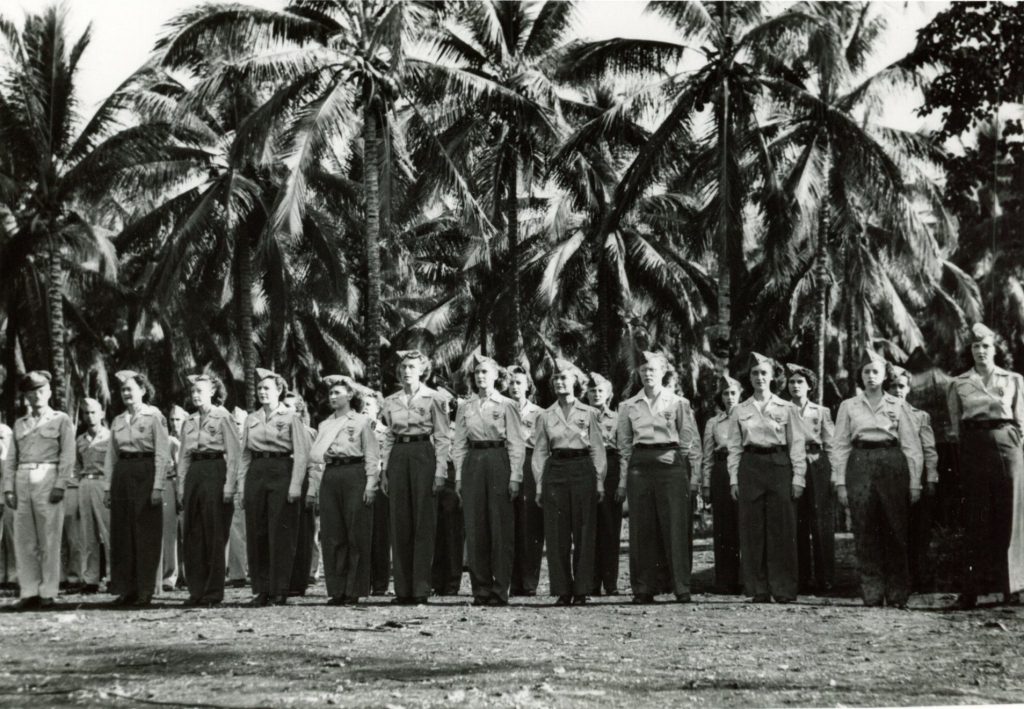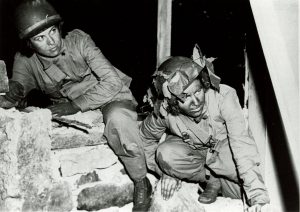The last in a series of Blogs about the 31 Medical Air Evacuation
Transport Squadrons activated during WW2
to provide inflight nursing care to sick and wounded soldiers,
tended by Army flight nurses and enlisted technicians.
The focus is on the flight nurses.
Epilogue
At the height of World War II, 500 Army flight nurses served with the AAF as members of 31 MAES located throughout the world. 1 Flight nurses and enlisted technicians participated in the major campaigns on both the European and Pacific fronts as soon as it was feasible to send in transport planes. Their work was not insignificant – over 1 million patients were evacuated by air between January 1943 and May 1945. Air Surgeon of the AAF David N.W. Grant credited air evacuation among the 5 wartime achievements that were great life–saving measures; blood plasma, front–line surgery, penicillin, and sulfa drugs completed his list. 2
Faced with mounting casualty rates from about 5,000 a month in 1943 to 81,000 a month by the end of 1944, military leaders were quick to realize the value of flight nurses and enlisted technicians in making the newly organized air evacuation program a success. These specially trained medical personnel, often decorated for their participation as members of the 31 MAES activated during the war, had taken the care of sick and wounded soldiers to new heights.

Award of Air Medal to 801 MAETS flight nurses,
Guadalcanal, July 1944 (USAF Photo)
With Japan’s surrender in September 1945, the planned redeployment of MAES from other theaters to the Pacific was not required. By December 1945 most of the MAES were either deactivated or had been disbanded and reformed as numbered Flights in the 830 MAES. By the end of the war, over half of the MAES had been incorporated into the 830 MAES.
In 1946 only the 801 MAES, the 806 MAES, the 830 MAES, and the 831 MAES still were active. The 801 MAES – the first squadron sent to the Pacific – moved 3 flight nurses from Clark AB in the Philippines to Tachikawa, Japan in September 1946; the rest of the squadron remained at Clark. 3 The 806 MAES – the first squadron sent to Europe – was the last remaining when in the autumn and winter of 1945 to 1946, it was stationed at Villacoublay Airdrome, Paris and flew special missions aboard troop carrier planes. In May 1946 the 806 MAES moved to Wiesbaden, Germany to accompany patients back to Orly Field, France, and moved to Munich in September 1946 before it finally was deactivated in May 1947. 4
In May 1946 the Pacific Division retained 5 Flights of the 830 MAES at Hickam Field, Oahu from which it dispatched air evacuation teams to Guam who, after 24 hours crew rest were sent to Tokyo or Manilla to pick up patients for air evacuation. In September 1946, Flights of the 830 MAES at Topeka, KS were redistributed, with a detachment sent to Westover Field, MA and another to Warner–Robins Field, GA, and a few months later the third detachment was sent to Lowry Field, CO. 5
Early in 1947, 2 Flights of the 830 MAES were transferred from Rhein–Main AB, Germany to Westover AB, MA, leaving 1 Flight attached to the European Division to accompany home–bound patients before that Flight was transferred to Westover in July 1947. In June 1947 Flight 1 of the 830 MAES was transferred from Anchorage, Alaska to Great Falls AB, MT. 6
The 831 MAES, which had been deactivated in December 1945 and absorbed into the 830 MAES, was reactivated in July 1946 as an operational and training unit of the School of Aviation Medicine at Randolph Field, TX, which had incorporated the flight nurse and enlisted technician courses when the School of Air Evacuation closed at Bowman Field, KY in October 1944. 7
| Squadron | Activated | Deactivated or Disbanded |
| 801 MAETS | Dec 1942 | Remained at Clark AB, Philippines; 6 flight nurses transferred to Tachikawa, Japan Sep 1946 |
| 802 MAETS | Dec 1942 | Deactivated Dec 1945 |
| 803 MAETS | Dec 1942 | Deactivated Dec 1945; incorporated into 830 MAES |
| 804 MAETS | Dec 1942 | Deactivated Mar 1946 |
| 805 MAETS | Dec 1942 | Disbanded Nov 1944; incorporated into 830 MAES |
| 806 MAETS | Dec 1942 | Remained in Villacoublay, France; transferred to Munich, Germany Sep 1946; deactivated May 1947 |
| 807 MAETS | May 1943 | Deactivated Dec 1945 |
| 808 MAETS |
Jun 1943 |
Disbanded Nov 1944; incorporated into 830 MAES |
| 809 MAETS |
Jun 1943 |
Disbanded Dec 1945; incorporated into 830 MAES |
| 810 MAETS | Aug 1943 | Disbanded May 1945; incorporated into 830 MAES |
| 811 MAETS |
Sep 1943 |
Deactivated Dec 1945 |
| 812 MAETS |
Sep 1943 |
Disbanded Dec 1945; incorporated into 830 MAES |
| 813 MAETS |
Oct 1943 |
Deactivated Dec 1945 |
| 814 MAETS |
Oct 1943 |
Disbanded May 1945; incorporated into 830 MAES |
| 815 MAETS |
Nov 1943 |
Disbanded May 1945; incorporated into 830 MAES |
| 816 MAETS |
Nov 1943 |
Deactivated Dec 1945 |
| 817 MAETS |
Nov 1943 |
Deactivated Dec 1945 |
| 818 MAETS |
Nov 1943 |
Deactivated Dec 1945 |
| 819 MAETS |
Nov 1943 |
Deactivated Dec 1945 |
| 820 MAETS |
Nov 1943 |
Deactivated Mar 1946 |
| 821 MAETS |
Jan 1944 |
Deactivated Dec 1945 |
| 822 MAETS |
Jan 1944 |
Disbanded Nov 1944; incorporated into 830 MAES |
| 823 MAETS |
Mar 1944 |
Disbanded Nov 1944; incorporated into 830 MAES |
| 824 MAETS |
Mar 1944 |
Disbanded Nov 1944; incorporated into 830 MAES |
| 825 MAETS |
Apr 1944 |
Disbanded Nov 1944; incorporated into 830 MAES |
| 826 MAETS |
May 1944 |
Disbanded Nov 1944; incorporated into 830 MAES |
| 827 MAETS |
Jun 1944 |
Disbanded Nov 1944; incorporated into 830 MAES |
| 828 MAETS |
Jul 1944 |
Disbanded Nov 1944; incorporated into 830 MAES |
| 829 MAES |
Aug 1944 |
Disbanded Nov 1944; incorporated into 830 MAES |
| 830 MAES |
Nov 1944 |
Still active in 1947 |
| 831 MAES |
Nov 1944 |
Disbanded Dec 1945; incorporated into 830 MAES; reactivated Jul 1946 as operational and training unit for School of Aviation Medicine, Randolph AFB TX |
The winding down of 801 MAES involvement in WW2 was literally straight out of a movie:
We were all sitting in the movie area which faces Leyte Gulf, viewing a picture, the name of which one and all has long since forgotten when varied color lights and rockets appeared on the many ships in the harbor. Some one had the presence of mind to rush to a radio. Then came the shout, Japan has surrendered.” … To many of us the Hollywood style Christmas tree scene in the harbor will be one long to be remembered.
Squadron personnel were watching an outdoor movie in view of Leyte Harbor when the sky lit up with varied–color lights and rockets from its many ships. The title of the movie was forgotten but not the “Hollywood style Christmas tree scene” that brought news of Japan’s surrender. 8
The MAES personnel had mixed emotions about ending their overseas tours of duty. When the flight nurses of the 821st MAES received orders to return to the US from their base in India, some nurses were “in a dither” and could not get home soon enough,
while others were very sad indeed, and angry also. These few (about seven) didn’t want to go home at all. … It was commonly known among the Squadron that most of the Nurses had “bucked” to go home, and that those left wanted to stay for various reasons – flying pay, medals, glamour, privacy, attention. But the fact remained that “orders were orders”. 9
“So concludes our time together as the 821st Medical Air Evacuation Squadron,” wrote Katherine Hack. “Now we are going away, and each on her own way. It has been an experience with a capital E, and with deepest regrets do we see ourselves parted from it.’ 10
The unit historian for the 817 MAETS in Europe had similar emotions as his squadron’s wartime service overseas came to an end:
Parting was really such sweet sorrow when disbandment finally came. It was more like a graduating class departing after much class association. Friendships made in the squadron will be enduring long afterward.” …
“Perhaps the memory of having served his and her country through being with this squadron will instill in the minds of each man and nurse an ideal of democracy, liberty, and justice which will be everlasting. 11
This series about the MAETS activated in WW2 ends where it began, with the 801 MAETS in the Pacific. “It would appear, and it’s true, that we like our jobs even though we wish ardently for an end to the war,” wrote flight nurses Nancy Preston and Ada Endres in an eloquent conclusion to “The Feminine Side” – their personal account of flight nursing in the 801 MAETS during WW2 that was included in the squadron history.
The peace of mind which we enjoy even under these circumstances, though, must have some foundation; we attribute our ‘esprit de corps’ to a great many things: to the fact that we’re a well–trained group; to the fact that our work is voluntary; to our good health and hardiness; to the good–will and friendliness and helpfulness which we meet everywhere; but, above all, to the fact that something about all this makes us feel truly like real citizens of the world. 12
For more about the 31 MAETS activated during World War II and the flight nurses in those squadrons, see Beyond the Call of Duty: Army Flight Nursing in World War II.
Notes
- Official Guide to the Army Air Forces (New York: Simon and Schuster, 1944), 94.
- David N.W. Grant, “Five Wartime Achievements of the Army Air Forces Medical Service”, speech prepared for International Medical Assembly, Interstate Postgraduate Medical Association of North America, Chicago, IL, 18 Oct 1944, 21. [AFHRA 141.28–91 1943–1945]
- Robert F. Futrell, Development of Aeromedical Evacuation in the USAF, 1909–1960, Historical Studies No. 23 (Maxwell AFB, AL: USAF Historical Division, Research Studies Institute, Air University; Manhattan, KS: Military Affairs / Aerospace Historian, 1960), 498.
- Ibid., 474–75, 489, 491–92.
- Ibid., 484–85, 500.
- Ibid., 493, 496.
- Ibid., 479–80.
- Paul H. Cronenwett, “Historical Data: 1 August 1945 to 31 August 1945”, 801 MAES, 5 Sep 1945, 4.
- “History For the month of June 1945”, 821 MAES, 4 Jul 1945, 1.
- Katherine S. Hack, “Nurses: May, 1945”, 821 MAES, 3 Jun 1945, 5. [AFHRA MED–821–HI]
- “Historical Data 817th (US) Medical Air Evacuation Squadron, September 1 –October 13, 1945”. [AFHRA MED–817–HI]
- 12.
- Nancy L. Preston and Ada M.S. Endres, “The Feminine Side”, 801 MAETS, Aug 1944, 6–7. [AFHRA MED–801–HI]



